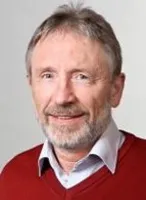
Wolfgang Domcke
Prof. Dr. rer. nat. Dr. h.c.
Deputy Ombudsperson, TUM
Former Professor of Theoretical Chemistry
TUM School of Natural Sciences
born 1948
Interview with TUM Emeritus of Excellence Wolfgang Domcke
"My life is governed by science and sports"
For Wolfgang Domcke no goal is too challenging, neither in the areas of Physics or Chemistry, nor in Sports. As an Emeritus he still conducts frontier research at TUM, unless he is out and about on his mountain bike. [read more]
CV
Prof. Domcke's research focuses on the calculation of photoinduced chemical dynamics of polyatomic molecules. The methods comprise the ab initio calculation of electronic potential energy areas, the description of quantum mechanical wave packet dynamics as well as molecular spectra, especially time-resolved spectra of ultrafast photochemical processes. The main questions are the understanding of the photostability of biological molecules and the elementary processes of splitting water with sunlight. After studying physics and obtaining his doctorate in theoretical physics at the TUM, he habilitated at the Faculty of Physics of the University of Freiburg i. Br. After a stay abroad at the California Institute of Technology he was Professor (C2) for Theoretical Chemistry at the University of Heidelberg, Professor (C3) at the TUM (1986 - 1995) and Professor (C4) at the Heinrich Heine University Düsseldorf. From 1999 - 2013 he held the chair of Theoretical Chemistry at the TUM. Prof. Domcke is a member of the International Academy of Quantum Molecular Science, Fellow of the Royal Society of Chemistry and an external member of the Polish Academy of Sciences. Approx. 420 scientific Publications, Hirsch Index 75 (2017).
Short biography
| 1972 | Diploma in Physics, TU Munich |
| 1972-1975 | Doctorate (Dr. rer. nat.) in Theoretical Physics, scientific assistant at the chair, TU Munich |
| 1976- 1979 | Habilitation in theoretical Physics, Albert-Ludwigs-University, Freiburg |
| 1982 | Research stay as a DFG scholarship holder, California Institute of Technology, Pasadena |
| 1982 – 1986 | Professor for theoretical Chemistry, Ruprecht-Karls-University Heidelberg |
| 1986 – 1995 | Professor for physical and theoretical chemistry, TU Munich |
| 1996 – 1999 | Professor for theoretical Chemistry, Heinrich-Heine-University, Düsseldorf |
| 1999 – 2013 | Professor for theoreticale Cehmistry, TU Munich |
| seit 2022 | Deputy Ombudsperson, TU Munich |
Memberships and honors
Member of the International Academy of Quantum Molecular Science
Fellow of the Royal Society of Chemistry
External member of the Polish Academy of Sciences
Awards
- The Löwdin Lectures, University Uppsala (2007)
- Copernicus Award (2008)
- Honorary doctorate of the Karls-Universtiy in Prag (2012)
Key publications
Sobolewski AL, Domcke W. “Excited-state singlet-triplet inversion in hexagonal aromatic and heteroaromatic compounds”. Phys. Chem. Chem. Phys. 2023, 25: 21875
Gelin MF, Chen L, Domcke W. “Equation-of-motion methods for the calculation of femtosecond time-resolved four-wave-mixing and N-wave-mixing signals”. Chem. Rev. 2022, 122: 17339
Domcke W, Sobolewski AL. “Water oxidation and hydrogen evolution with organic photooxidants: A theoretical perspective”. J. Phys. Chem. B 2022, 125: 2777
Gelin MF, Huang X, Xie W, Chen L, Došlić N, Domcke W. “Ab initio surface-hopping simulation of femtosecond transient absorption pump-probe signals of nonadiabatic excited-state dynamics using the doorway-window representation”. J. Chem. Theory Comput. 2021, 17: 2394
Ehrmaier J, Rabe EJ, Pristash SR, Corp KL, Schlenker CW, Sobolewski AL, Domcke W. “Singlet-triplet inversion in heptazine and in polymeric carbon nitrides”. J. Phys. Chem. A 2019, 123: 8099
Ehrmaier J, Karsili TNV, Sobolewski AL, Domcke W. “Mechanism of photocatalytic water splitting with graphitic carbon nitride: Photochemistry of the heptazine-water complex”. J. Phys. Chem. A 2017, 121: 4754
Marchetti B, Karsili TNV, Ashfold MNR, Domcke W. “A bottom-up, ab initio computational approach to understanding fundamental photophysical processes in nitrogen containing heterocycles, DNA bases and base pairs”. Phys. Chem. Chem. Phys. 2016, 18: 2007
Explanations of prizes and awards can be found here [pdf to download 215 KB].